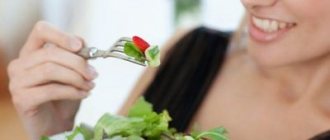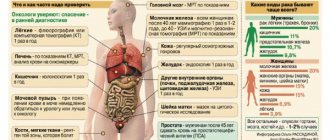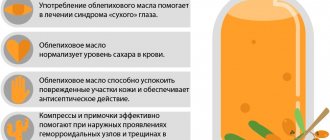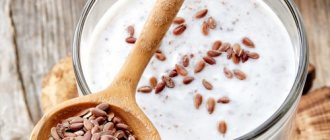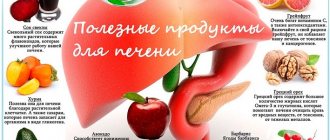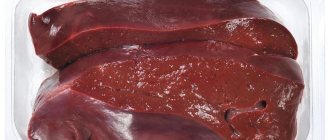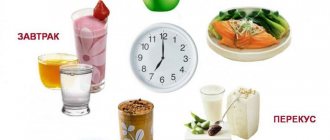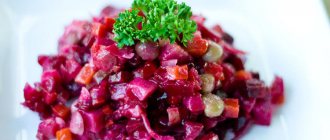The text is for informational purposes only. We strongly urge you not to use diets, resort to any therapeutic menus or fasting without medical supervision. We recommend reading: “Why can’t you go on a diet on your own?”
It's no secret that the treatment of any gastric disease requires the patient to follow a diet. This is the only way to normalize the full functioning of the gastrointestinal tract and eliminate many unpleasant symptoms. This rule also applies to reflux esophagitis, an extremely common pathology of the digestive system. The main signs of reflux esophagitis are heartburn, belching, pain and a burning sensation in the sternum. Symptoms are usually worse after eating or lying down.
Acid reflux occurs when the contents of the stomach enter a person's esophagus. This pathological condition is also called gastroesophageal reflux or acid regurgitation, or simply GERD.
But how does it differ from ordinary heartburn? Heartburn is one of the typical symptoms of acid reflux. Most people experience this condition occasionally, so it does not cause them much concern. But a frequent feeling of heartburn (twice a week or even more often) may indicate the presence of GERD, a chronic type of reflux that can provoke the development of unpleasant complications if left untreated. This pathology occurs in 20% of people.
General rules
Gastroesophageal reflux disease is characterized by the development of reflux of gastric contents into the esophagus and the appearance of corresponding symptoms - heartburn after eating fatty, spicy, sour foods and belching of stomach contents. Gastroesophageal reflux is caused by increased intra-abdominal pressure, incompetence of the lower esophageal sphincter, or hiatal hernia. An increase in intra-abdominal pressure is observed with obesity , constipation , pregnancy , flatulence , and disorders of gastric and duodenal emptying.
Sphincter tone can be reduced by smoking, consumption of fats and foods containing nitrates and food preservatives. In addition, the decrease in tone progresses with age. The most common complication of this disease is reflux esophagitis, which is detected in a third of patients. The refluxant has an aggressive effect on the mucous membrane of the esophagus and its constant reflux leads to damage to it with the development of functional, catarrhal or erosive-ulcerative disorders. Symptoms of the disease depend on the nature of the damage to the mucous membrane - catarrhal esophagitis (there is superficial inflammation) or erosive (there are erosions).
For a long time, these forms were regarded as successive stages of the disease - first, it is not erosive esophagitis that supposedly occurs, but erosive esophagitis was already considered a complication of the first. The results of observations suggest that forms have no tendency to transform one into another and exist independently of each other. Patients with this disease are bothered by belching, chest pain and discomfort when food passes through the esophagus. The presence of severe complications - bleeding from erosions, esophageal strictures, the formation of adenocarcinoma and Barrett's esophagus - necessitate early diagnosis and treatment of the disease.
The diet for reflux esophagitis is aimed at reducing the frequency of reflux and creating conditions for eliminating inflammation and healing erosions. Since reflux esophagitis causes a violation of the regimen, amount of nutrition and its quality, as well as constipation , the therapeutic diet should include all these points.
Patients should avoid eating fatty and fried foods. With reflux esophagitis, overeating is not allowed, especially at night. It is also necessary to observe a diet - frequent meals in small portions. The principle of a rational diet is also mechanically and chemically gentle nutrition.
It is prohibited to consume alcohol, drinks, as well as foods that cause flatulence , as this provokes reflux into the esophagus. Drinking carbonated drinks, coffee and large volumes of liquid contributes to the appearance of reflux and this must be taken into account when following a diet.
Water regime should be limited to 1 liter per day. Drinks should be consumed during meals, but not after them. To prevent constipation, include foods rich in fiber in your diet. The most acceptable and permitted for this disease are boiled beets (grated on a fine grater or puree), as well as soaked and mashed prunes.
During the period of exacerbation in the presence of pain and severe heartburn, nutrition should be as gentle as possible, therefore Table No. 1A . It is especially indicated for erosive esophagitis and should be observed for up to 10 days, since the nutrition of this table is unbalanced and has low calorie content. Bread and bakery products, any broths, vegetables and fruits in any form, carbonated drinks, coffee, strong tea, cocoa, undiluted fruit juices, any sauces and spices are excluded. Meat dishes are consumed once a day, and the basis of the diet is slimy or pureed soups and liquid porridges.
This table includes:
- Meat dishes (beef, chicken) in the form of a steam soufflé, for the preparation of which the boiled meat is thoroughly beaten in a blender or scrolled several times in a meat grinder.
- Fish dishes (cod, pike, hake, pollock and ice fish are used) in the form of a soufflé.
- Slimy soups (cereals: oatmeal, semolina, rice) with the addition of an egg-milk mixture. Flour is widely used for baby food, from which soups and rare cereals are prepared.
- Dishes made from cereal flour or pureed cereals (buckwheat, oatmeal, rice) are prepared in the form of liquid porridge and milk is added.
- Pasteurized low-fat milk, calcined cottage cheese, milk jelly and low-fat cream.
- Soft-boiled eggs or omelet.
- Kissels and jelly made from berries, but fresh berries are excluded.
- Sugar, honey
- Weak tea with cream, rosehip infusion and wheat bran decoction.
After this, the patient is transferred to loading Diet No. 1B , and he can stick to it for up to two weeks. The amount of protein in it is increased to 100 g, mainly due to milk proteins (the patient is allowed to consume more milk, cottage cheese and milk porridges), since they are considered easily digestible. Meat and fish dishes are still recommended once a day.
- Hot and cold dishes are excluded, as they slow down the restoration processes of the mucous membrane.
- The diet is expanded with pureed soups with the addition of pureed vegetables (potatoes, carrots, beets).
- Meat, chicken and fish dishes can be eaten not only in the form of soufflés, but also mashed potatoes, quenelles and cutlets.
- Canned vegetables and fruits from the baby food series are being introduced.
- Additionally, you can add barley, but it is well boiled and pureed, followed by the addition of milk and butter. If discomfort occurs, it is excluded from the diet.
- Some vegetables (potatoes, carrots, beets and zucchini) can be eaten as a puree. Fruits and vegetables are still not allowed to be eaten raw.
- The number of eggs increases to 3 per day.
- You can drink milk up to 4 times a day; fresh cottage cheese is allowed twice a day (milk is added to it and pureed), milk jelly and cream, which are added to soups or tea.
As the patient's condition improves and during remission, the patient's nutrition is expanded within Table No. 1 . This diet is complete and moderately gentle. It contains a reduced total amount of animal fats, which reduce the tone of the esophageal sphincter (heavy cream, butter, pork, goose, duck, fatty fish, fatty lamb, confectionery, creams).
Irritating foods are excluded: citrus fruits, coffee, tea, tomatoes, chocolate, onions, garlic, mint, alcohol, which also reduce its tone. The amount of protein component increases to 100 g per day, which helps to increase sphincter tone.
- Secretion agents and rough foods with connective tissue (stringy meat, cartilage) are excluded.
- Fractional meals are provided.
- Avoid vegetables with coarse fiber and essential oils (turnips, radishes, onions, garlic, asparagus, legumes), fruits with coarse skin (gooseberries, grapes, dates, currants), bread with bran.
- The food is steamed, served mushy and, at first, pureed. Baking without a rough crust is possible.
- The first half of the day should account for most of the calories, and the last meal should contain easily digestible foods (vegetable dishes, fermented milk, cereals, omelettes).
Following these recommendations can also prevent stomach contents from refluxing into the esophagus:
- Do not take a horizontal position immediately after eating.
- Lose weight if you are obese.
- Avoid bending forward, staying in a bent position for long periods of time, lifting heavy objects, tight clothing and tight belts - all of this increases intra-abdominal pressure and increases regurgitation.
- Light dinner 4 hours before bedtime.
- Avoid constipation and flatulence.
- Stop smoking and drinking alcohol.
- Use a high pillow to sleep (raise your head 15-20 cm).
- Take alkaline mineral waters (they reduce acidity, reduce inflammation of the mucous membrane and the frequency of regurgitation).
Recipes
First meal
Oatmeal soup with pureed meat
Boil the meat, beat in a blender. Boil the oatmeal well and puree, dilute with water, add salt, add boiled meat, bring to a boil and at the end add a piece of butter.
Vegetarian potato soup with zucchini and carrots
Boil potatoes, carrots and zucchini and puree. Combine with vegetable broth, add salt, milk or cream and bring to a boil.
Second courses
Steamed fish soufflé
Boil lean fish fillet and blend in a blender. Mix white sauce made from flour and milk with minced meat, add lightly beaten yolk, salt and add butter. Beat the whites separately and carefully fold into the minced meat. Place the mixture in a mold and steam.
Steamed meatballs
Boil the rice and carrots and pass through a meat grinder. Add the egg and rice-carrot mixture to the ground beef. Add salt to form meatballs and steam.
Authorized Products
- For esophageal esophagitis, soups are prepared only with vegetable broth, and cereals and vegetables in soups are pureed. Ready-made soups are seasoned with egg-milk mixture and butter. Sautéing vegetables for soups is not permitted.
- Dried wheat bread is allowed in quantities up to 200 g.
- Beef, lamb, turkey and chicken, lean pork are prepared boiled and rolled; cutlets, soufflés and quenelles can be made. Baking without a crust with sauces (milk or sour cream) is not contraindicated.
- Dishes from low-fat varieties of fish are consumed in the form of cutlets or in pieces.
- It is better to choose more gentle cereals - semolina, buckwheat or rice. They are boiled in water or with milk. Buckwheat and rice porridges are pureed and brought to a semi-viscous state with milk.
- Milk, low-fat cream (in dishes) and non-acidic kefir, you can make milk jelly and milk cream. Cottage cheese is chosen with medium fat content and consumed in its natural form (well mashed and slightly diluted with milk), as well as in the form of a soufflé or pudding. Avoid fermented milk drinks with high acidity from the diet.
- Butter in the amount of 20 g and refined sunflower oil are used in ready-made dishes.
- Vegetables with low fiber content are allowed (potatoes, beets, cauliflower, pumpkin, carrots). They are consumed boiled and pureed. You can eat vegetable puddings.
- Drinks include milk tea, fruit teas, sweet fruit juices, herbal teas (mint tea is excluded). Sugar or honey is added to teas and decoctions.
- You can make purees, jelly, jelly and compotes from sweet fruits. Avoid eating raw fruits.
Table of permitted products
| Proteins, g | Fats, g | Carbohydrates, g | Calories, kcal | |
Vegetables and greens | ||||
| zucchini | 0,6 | 0,3 | 4,6 | 24 |
| cauliflower | 2,5 | 0,3 | 5,4 | 30 |
| potato | 2,0 | 0,4 | 18,1 | 80 |
| carrot | 1,3 | 0,1 | 6,9 | 32 |
| beet | 1,5 | 0,1 | 8,8 | 40 |
| pumpkin | 1,3 | 0,3 | 7,7 | 28 |
Cereals and porridges | ||||
| buckwheat (kernel) | 12,6 | 3,3 | 62,1 | 313 |
| semolina | 10,3 | 1,0 | 73,3 | 328 |
| cereals | 11,9 | 7,2 | 69,3 | 366 |
| white rice | 6,7 | 0,7 | 78,9 | 344 |
Bakery products | ||||
| wheat bread | 8,1 | 1,0 | 48,8 | 242 |
Confectionery | ||||
| jelly | 2,7 | 0,0 | 17,9 | 79 |
Raw materials and seasonings | ||||
| honey | 0,8 | 0,0 | 81,5 | 329 |
| sugar | 0,0 | 0,0 | 99,7 | 398 |
| milk sauce | 2,0 | 7,1 | 5,2 | 84 |
| sour cream sauce | 1,9 | 5,7 | 5,2 | 78 |
Dairy | ||||
| milk | 3,2 | 3,6 | 4,8 | 64 |
| cream 9% | 2,8 | 9,0 | 4,0 | 107 |
Cheeses and cottage cheese | ||||
| cottage cheese | 17,2 | 5,0 | 1,8 | 121 |
Meat products | ||||
| boiled beef | 25,8 | 16,8 | 0,0 | 254 |
| boiled veal | 30,7 | 0,9 | 0,0 | 131 |
| rabbit | 21,0 | 8,0 | 0,0 | 156 |
Bird | ||||
| boiled chicken | 25,2 | 7,4 | 0,0 | 170 |
| turkey | 19,2 | 0,7 | 0,0 | 84 |
Eggs | ||||
| chicken eggs | 12,7 | 10,9 | 0,7 | 157 |
Oils and fats | ||||
| butter | 0,5 | 82,5 | 0,8 | 748 |
Non-alcoholic drinks | ||||
| mineral water | 0,0 | 0,0 | 0,0 | — |
Juices and compotes | ||||
| jelly | 0,2 | 0,0 | 16,7 | 68 |
| rose hip juice | 0,1 | 0,0 | 17,6 | 70 |
| * data is per 100 g of product | ||||
General rules. Duration of the diet.
The main task of therapeutic nutrition for esophageal esophagitis is to completely eliminate damage to the mucous membrane by mechanical and chemical factors.
For esophagitis, table No. 1 is prescribed. In nutrition you must adhere to a number of rules:
- the number of meals should be 5-6 times. Portions are small. This dietary tactic for esophagitis allows the stomach to stretch unnecessarily and produce excess hydrochloric acid.
- Food should not be too hot or cold. The optimal temperature for food is 25-50 C.
- You can't eat on the go. You need to eat slowly and chew your food thoroughly.
- You should not drink water immediately after eating. It is permissible to drink only 30-40 minutes after eating.
- Dishes can be steamed, stewed, baked or boiled. You can't fry.
- Limit salt intake as much as possible.
Fully or partially limited products
- Pickled vegetables, mushrooms in any form.
- Fatty and coarse meat, canned food, smoked meats, fatty duck and goose meat, meat and fish broths, pickled fruits and vegetables.
- Fried foods, tomato and mushroom sauces, mushroom decoctions, stewed meat and fish, as they contain a large amount of extractive substances. Broths made from bouillon cubes, dishes with mayonnaise.
- Sour berries and fruits, raw vegetables during an exacerbation period, nuts.
- Puff pastry, yeast and butter dough, fresh bread.
- Tomatoes in any form, onions, garlic, mushrooms, radishes, white cabbage, sorrel, radishes, legumes, cucumbers.
- Condiments, spices, hot sauces, vinegar, horseradish, mustard, mayonnaise, ketchup, tomato paste, lemon juice are not acceptable even as a seasoning for dishes.
- Pasta, millet, pearl barley and barley cereals, as they are coarse and difficult to digest.
- Fermented milk products taste sour.
- Sour juices (citrus, tomato, pomegranate, currant), carbonated drinks, alcohol, coffee, strong tea, mint tea, wine and beer.
- Chocolate and chocolate products, halva.
Table of prohibited products
| Proteins, g | Fats, g | Carbohydrates, g | Calories, kcal | |
Vegetables and greens | ||||
| vegetables legumes | 9,1 | 1,6 | 27,0 | 168 |
| canned vegetables | 1,5 | 0,2 | 5,5 | 30 |
| corn | 3,5 | 2,8 | 15,6 | 101 |
| radish | 1,2 | 0,1 | 3,4 | 19 |
| white radish | 1,4 | 0,0 | 4,1 | 21 |
| black radish | 1,9 | 0,2 | 6,7 | 35 |
| turnip | 1,5 | 0,1 | 6,2 | 30 |
| asparagus | 1,9 | 0,1 | 3,1 | 20 |
| tomatoes | 0,6 | 0,2 | 4,2 | 20 |
| horseradish | 3,2 | 0,4 | 10,5 | 56 |
| garlic | 6,5 | 0,5 | 29,9 | 143 |
Fruits | ||||
| citrus fruits | 0,9 | 0,2 | 4,4 | 22 |
Berries | ||||
| grape | 0,6 | 0,2 | 16,8 | 65 |
| gooseberry | 0,7 | 0,2 | 12,0 | 43 |
| currant | 1,0 | 0,4 | 7,5 | 43 |
Nuts and dried fruits | ||||
| nuts | 15,0 | 40,0 | 20,0 | 500 |
| dates | 2,5 | 0,5 | 69,2 | 274 |
Cereals and porridges | ||||
| corn grits | 8,3 | 1,2 | 75,0 | 337 |
| pearl barley | 9,3 | 1,1 | 73,7 | 320 |
| millet cereal | 11,5 | 3,3 | 69,3 | 348 |
| barley grits | 10,4 | 1,3 | 66,3 | 324 |
Flour and pasta | ||||
| pasta | 10,4 | 1,1 | 69,7 | 337 |
Bakery products | ||||
| vysivkovy bread | 9,0 | 2,2 | 36,0 | 217 |
| oatmeal bread | 10,1 | 5,4 | 49,0 | 289 |
| bran bread | 7,5 | 1,3 | 45,2 | 227 |
| whole grain bread | 10,1 | 2,3 | 57,1 | 295 |
Confectionery | ||||
| jam | 0,3 | 0,2 | 63,0 | 263 |
| candies | 4,3 | 19,8 | 67,5 | 453 |
Ice cream | ||||
| ice cream | 3,7 | 6,9 | 22,1 | 189 |
Raw materials and seasonings | ||||
| carnation | 6,0 | 20,1 | 27,0 | 323 |
| mustard | 5,7 | 6,4 | 22,0 | 162 |
| ketchup | 1,8 | 1,0 | 22,2 | 93 |
| cinnamon | 3,9 | 3,2 | 79,8 | 261 |
| Bay leaf | 7,6 | 8,4 | 48,7 | 313 |
| mayonnaise | 2,4 | 67,0 | 3,9 | 627 |
| fresh mint | 3,7 | 0,4 | 8,0 | 49 |
| dried mint | 19,9 | 6,0 | 22,2 | 285 |
| cayenne pepper | 0,7 | 0,2 | 9,8 | 43 |
| ground red pepper | 0,7 | 0,3 | 4,6 | 21 |
| ground black pepper | 10,4 | 3,3 | 38,7 | 251 |
| chilli | 2,0 | 0,2 | 9,5 | 40 |
| tomato sauce | 1,7 | 7,8 | 4,5 | 80 |
| spicy tomato sauce | 2,5 | 0,0 | 21,8 | 98 |
| vinegar | 0,0 | 0,0 | 5,0 | 20 |
Dairy | ||||
| kefir | 3,4 | 2,0 | 4,7 | 51 |
| cream 35% (fat) | 2,5 | 35,0 | 3,0 | 337 |
| sour cream | 2,8 | 20,0 | 3,2 | 206 |
| curdled milk | 2,9 | 2,5 | 4,1 | 53 |
Cheeses and cottage cheese | ||||
| blue cheese | 20,0 | 29,0 | 0,0 | 340 |
| Chees Feta | 17,0 | 24,0 | 0,0 | 290 |
Meat products | ||||
| pork | 16,0 | 21,6 | 0,0 | 259 |
Sausages | ||||
| dry-cured sausage | 24,1 | 38,3 | 1,0 | 455 |
Bird | ||||
| smoked chicken | 27,5 | 8,2 | 0,0 | 184 |
| duck | 16,5 | 61,2 | 0,0 | 346 |
| smoked duck | 19,0 | 28,4 | 0,0 | 337 |
| goose | 16,1 | 33,3 | 0,0 | 364 |
Fish and seafood | ||||
| dried fish | 17,5 | 4,6 | 0,0 | 139 |
| smoked fish | 26,8 | 9,9 | 0,0 | 196 |
| canned fish | 17,5 | 2,0 | 0,0 | 88 |
Oils and fats | ||||
| creamy margarine | 0,5 | 82,0 | 0,0 | 745 |
| animal fat | 0,0 | 99,7 | 0,0 | 897 |
| cooking fat | 0,0 | 99,7 | 0,0 | 897 |
Alcoholic drinks | ||||
| whiskey | 0,0 | 0,0 | 0,4 | 235 |
| vodka | 0,0 | 0,0 | 0,1 | 235 |
| cognac | 0,0 | 0,0 | 0,1 | 239 |
| liquor | 0,3 | 1,1 | 17,2 | 242 |
| beer | 0,3 | 0,0 | 4,6 | 42 |
Non-alcoholic drinks | ||||
| Pepsi | 0,0 | 0,0 | 8,7 | 38 |
| sprite | 0,1 | 0,0 | 7,0 | 29 |
| green tea | 0,0 | 0,0 | 0,0 | — |
| black tea | 20,0 | 5,1 | 6,9 | 152 |
Juices and compotes | ||||
| Orange juice | 0,9 | 0,2 | 8,1 | 36 |
| grapefruit juice | 0,9 | 0,2 | 6,5 | 30 |
| lime juice | 0,0 | 0,0 | 8,2 | 25 |
| lemon juice | 0,9 | 0,1 | 3,0 | 16 |
| tangerine juice | 0,8 | 0,3 | 8,1 | 36 |
| tomato juice | 1,1 | 0,2 | 3,8 | 21 |
| * data is per 100 g of product | ||||
A gentle diet for chronic gastritis
The diet for chronic gastritis has certain features.
Often one of the symptoms of gastrointestinal problems is a complete loss of appetite. One way or another, a complete refusal of food will not benefit any patient, regardless of his diagnosis.
Therefore, after one and a half days allotted for therapeutic fasting, the patient will have to start eating. Of course, an immediate return to the usual diet will negatively affect the patient’s well-being, so the “hunger strike” should be stopped gradually.
So, at first, the patient should limit his menu to liquid porridges (rice or oatmeal) cooked in water. For dessert, the patient can allow himself some light baked goods, for example, crackers or dried wheat flour.
Of the drinks, only weak tea is allowed.
As soon as the patient feels better, fermented milk products (preferably low in sugar), pureed vegetables, and lean fish or meat can be included in his diet. All dishes should be steamed. As a last resort, cooking is acceptable. But the patient will have to give up anything fried or baked for a while.
The patient should adhere to the above strict diet for at least three days after stopping the fast. Then he will be allowed to switch to a more gentle diet. What is he like?
Menu for reflux esophagitis (Diet)
Nutrition for catarrhal esophagitis may be less sparing, however, if there is pain, it is better to wipe porridges and soups at first to minimize mechanical irritation of the esophagus with food.
Usually, in the presence of heartburn , milk is well tolerated, so patients can eat milk porridge for breakfast and dinner, and a glass of milk during the day and at night (you can use milk jelly). Breakfast and dinner may also include an omelet or low-sour cottage cheese. As pain and discomfort in the esophagus disappear, twisted meat and meatballs are added to soups. Meat or fish dishes are served with side dishes of cereals or boiled vegetables in the form of puree.
| Breakfast |
|
| Lunch |
|
| Dinner |
|
| Afternoon snack |
|
| Dinner |
|
| For the night |
|
| Breakfast |
|
| Lunch |
|
| Dinner |
|
| Afternoon snack |
|
| Dinner |
|
| For the night |
|
| Breakfast |
|
| Lunch |
|
| Dinner |
|
| Afternoon snack |
|
| Dinner |
|
| For the night |
|
The menu for erosive esophagitis includes more gentle dishes and is organized within Tables 1A - 1B .
| Breakfast |
|
| Lunch |
|
| Dinner |
|
| Afternoon snack |
|
| Dinner |
|
| For the night |
|
| Breakfast |
|
| Lunch |
|
| Dinner |
|
| Afternoon snack |
|
| Dinner |
|
| For the night |
|
| Breakfast |
|
| Lunch |
|
| Dinner |
|
| Afternoon snack |
|
| Dinner |
|
| For the night |
|
Can you eat sweets if you have GERD?
For GERD, sweets can be in the form of jelly, jelly, soufflé, or sweet fruit puree. The main rule is that the dishes do not cause irritation to the throat and esophagus and are easy to swallow and digest. Gastroenterologists do not recommend consuming chocolate; it provokes acid reflux and can cause exacerbation of esophagitis. Cakes and sweets are slowly digested, so they should not be consumed during an exacerbation of GERD. In a state of remission, a small portion of sweets is allowed, but not on an empty stomach.
The main problem when eating desserts is appetite control, especially in overweight people. Eat sweets after the main course, but do not allow yourself to feel heavy and overeated.
If candidal esophagitis is being treated, sweets must be completely abandoned. This will avoid the growth of pathogenic microflora.
Reviews and results
With GERD, the diet must be followed constantly to avoid complications such as esophagitis . In the presence of erosive esophagitis, proper dietary nutrition should become the norm, since relapses of the disease are common. By reviewing your diet, you can avoid exacerbations and feel good for many years. Dietary nutrition helps eliminate heartburn, belching, discomfort in the esophagus and heaviness in the stomach.
- “... Throwbacks into the esophagus caused inflammation, but without erosion (checked by gastroscopy). There was pain behind the sternum, a feeling of squeezing and belching of air. They prescribed treatment and told me to follow a diet until the inflammation goes away. In general, I did it for 1.5 months (mashed dishes), and then I started cooking and chopping, but no longer pureed. I noticed that citrus fruits, tomato paste, pickled and pickled vegetables cause heartburn. After heartburn, pain and heaviness appear, and then constipation. Everything turned out to be connected. I take pills and follow a diet - I felt an improvement, my stomach became lighter, and there was no belching or heartburn. With this diet I lost 4.5 kg. Now I eat everything, but in boiled form and have excluded foods that are potentially dangerous for heartburn”;
- “... I was bothered by heartburn periodically, but for many years (probably 5 or 6). All this time I didn’t attach any importance to it - I prescribed medication for heartburn myself, but didn’t stick to the diet. Over the past month, unpleasant sensations have appeared along the esophagus; it even seemed that the pain intensified when swallowing and passing food. During the examination, erosions were found. I agreed to be hospitalized because at home I wouldn’t be able to take care of my treatment, eat right and take pills by the hour. After 2 weeks, the erosions healed - not even a trace was visible. She continued to follow the diet for up to 4 months. Of course, I ate everything that was not pureed like in the hospital, but boiled or baked in foil (this way a crust does not form and the dishes turn out steamed). I feel good, but apparently I need to follow the diet constantly - after a piece of fried meat, slight heartburn and belching appeared again. I came to the conclusion that you need to follow a diet constantly”;
- “... Esophagitis for many years, it’s good that there are no erosions. In the event of an exacerbation, I immediately take the diet and treatment prescribed by the doctor. I noticed that aggravation is caused by errors in diet (fried fish or cutlets, sour fruits, salads with mayonnaise and pickled cucumbers). It gets worse after eating sweets (jam, honey, candies, halva) - immediately heartburn and belching. You can’t overeat and work in an inclined position, as this worsens the situation, and then even pills don’t help.”
Will apple cider vinegar and lemon juice help?
Lemon water. Lemon juice itself, in its pure form, has a very sour taste. However, added in small quantities along with honey to warm water, it can have an alkalizing effect, neutralizing stomach acid. Honey also contains natural antioxidants, which provides additional protection for cellular health.
Apple vinegar. There is no official confirmation of the benefits of using apple cider vinegar for GERD, but many people who use this product claim its healing powers. Vinegar should not be consumed in its undiluted, pure form; it is a strong acid that causes irritation to the esophagus. A small amount of vinegar should be diluted in a glass of water (warm). You should drink water with vinegar during meals.
Therapeutic diet for pyloric stenosis
Pyloric stenosis is a condition in which food cannot pass freely from the stomach to the duodenum. This disease is treated through surgery. Until the moment the patient is scheduled for surgery, he needs special nutrition to alleviate his condition.
The essence of the therapeutic diet prescribed for pyloric stenosis is to reduce the amount of carbohydrates consumed by the patient. To achieve the goal, starch-containing foods are almost completely excluded from the patient's diet. Thus, the daily intake of bread, cereal or potatoes for a patient with pyloric stenosis should not exceed 250 grams (in total).
The calorie deficit resulting from the changes is compensated by increasing the consumption of proteins and fats. As for the diet, the patient is transferred to three meals a day. In this case, the patient is prohibited from eating at night and drinking a lot of liquid.
